Reminiscing

 Sometimes, a picture can instill such a strange awareness within us that it is hard to get the picture out of our heads. It doesn’t have to be something horrible, bloody, or shocking, but simply something unusual. The phone tower in Stockholm, Sweden, built in 1887 is that kind of a picture, for sure.
Sometimes, a picture can instill such a strange awareness within us that it is hard to get the picture out of our heads. It doesn’t have to be something horrible, bloody, or shocking, but simply something unusual. The phone tower in Stockholm, Sweden, built in 1887 is that kind of a picture, for sure.
Technology has changed so much over the years, and this tower was a relic of the past. That is probably why the image has stuck in my head all this time. The tower served its purpose at the time, connecting 5,000 telephone wires and providing service to all those people, but to me it seemed rather dangerous in many ways. The telephone was an amazing invention, but somehow, the idea of buried cable never occurred to the inventor or the engineers who made it a reality for everyone. The service was very expensive, and so only for the wealthy…a fact that would change in years to come.
Similar towers sprang up around the world, and most residents soon grew to hate the massive amounts of lines that littered their skyline. Still, it was the only way at the time, and the telephone was, after all, an important invention. Too bad they couldn’t immediately come up with the wireless version we all enjoy these days. The telephone towers were used shortly before telephone companies started burying their wires in about 1913.
The change was well received, since most residents hated it, and some of the work was done after a snowstorm downed telephone poles, causing the cities to pay for the changes. Soon the hated phone lines began to disappear. I can see why the towers are hated, and to this day, most photographers hate to have the towers 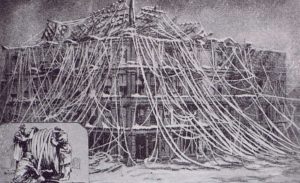
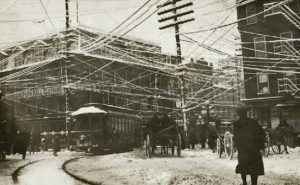 and wires in their photographs. I have often found myself wishing the wires were missing from that perfect shot I got as my husband and I walked along the walking paths in Casper, so I can understand the way the residents of Stockholm, New York, and Boston felt about the monstrosity that was the telephone lines in their cities. Thankfully for the residents, the problem was solved when the tower burned down on July 25, 1953.
and wires in their photographs. I have often found myself wishing the wires were missing from that perfect shot I got as my husband and I walked along the walking paths in Casper, so I can understand the way the residents of Stockholm, New York, and Boston felt about the monstrosity that was the telephone lines in their cities. Thankfully for the residents, the problem was solved when the tower burned down on July 25, 1953.
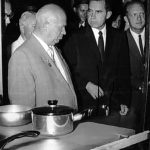 The debate between capitalism and communism is not new, and in fact has been going on for a long time. Possibly one of the strangest debates, known as the “kitchen debate” was between Vice President Nixon and Soviet leader Nikita Khrushchev. The debate was heated at times, but what was strangest about the debate was the fact that it took place in the middle of a model kitchen set up for an exhibit. Why they would have such a discussion in a model kitchen at a national exhibit is the really beyond me, but that is where it took place.
The debate between capitalism and communism is not new, and in fact has been going on for a long time. Possibly one of the strangest debates, known as the “kitchen debate” was between Vice President Nixon and Soviet leader Nikita Khrushchev. The debate was heated at times, but what was strangest about the debate was the fact that it took place in the middle of a model kitchen set up for an exhibit. Why they would have such a discussion in a model kitchen at a national exhibit is the really beyond me, but that is where it took place.
The so-called “kitchen debate” became one of the most famous episodes of the Cold War, and many think it might have really led to fighting words, had it not been for the two men controlling their tempers in the end. The meeting was set up in late 1958. In an effort to draw the two nations closer together, the Soviet Union and the United States agreed to set up national exhibitions in each other’s nation as part of their new emphasis on cultural exchanges. The Soviet exhibition opened in New York City in June 1959, and the United States exhibition opened in Sokolniki Park in Moscow in July. On July 24, before the Moscow exhibit was officially opened to the public, Vice President Nixon served as a host for a visit by Soviet leader Khrushchev. As Nixon led Khrushchev through the American exhibition, the Soviet leader’s famous temper began to flare. When Nixon demonstrated some new American color television sets, Khrushchev launched into an attack on the so-called “Captive Nations Resolution” passed by the United Stares Congress just days before. The resolution condemned the Soviet control of the “captive” peoples of Eastern Europe and asked all Americans to pray for their deliverance. I don’t suppose that resolution set well with Khrushchev, and coming right before the exhibition probably set the whole debate in motion.
After denouncing the resolution, Khrushchev then sneered at the United States technology on display, saying that the Soviet Union would have the same sort of gadgets and appliances within a few years. Nixon, was not a man to back down from a debate, so he cane right back and goaded Khrushchev by stating that the Russian leader should “not be afraid of ideas. After all, you don’t know everything.” The Soviet leader snapped at Nixon, “You don’t know anything about communism–except fear of it.” With a small army of reporters and photographers following them, Nixon and Khrushchev continued their argument in the kitchen of a model home built in the exhibition. With their voices rising and fingers pointing, the two men went at each other. I’m sure it was quite a show. Nixon suggested that Khrushchev’s constant threats of using nuclear missiles could lead to war, and he chided the Soviet for constantly interrupting him while he was speaking. Taking these words as a threat, Khrushchev warned of “very bad consequences.” Perhaps feeling that the exchange had gone too far, the Soviet leader then noted that he simply wanted “peace with all other nations, especially America.” Nixon, 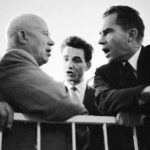 feeling slightly embarrassed said that he had probably not “been a very good host.” The debate, so quickly inflamed, fizzled in much the same way…at least between the two men…not so much the media.
feeling slightly embarrassed said that he had probably not “been a very good host.” The debate, so quickly inflamed, fizzled in much the same way…at least between the two men…not so much the media.
The “kitchen debate” was front-page news in the United States the next day. For a few moments, in the confines of a “modern” kitchen, the diplomatic gloves had come off and America and the Soviet Union had verbally jousted over which system was superior…communism or capitalism. As with so many Cold War battles, however, there was no clear winner…except perhaps for the United States media, which had a field day with the dramatic encounter. It was the sensationalism that the news media craves.
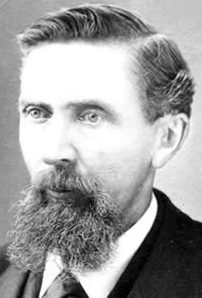 When Conrad Kohrs, immigrated to the United States at the age of 15, he was seeking his fortune like so many other immigrants were. The year was 1850, and while it is odd these days to think of a 15 year old boy immigrating to America alone now, it wasn’t entirely unheard of then. Kohrs was a native of Denmark, and had planned to head west to make his fortune in gold or silver. Unfortunately, while he had some small success in California and British Columbia, try as he might, the “big strike” always eluded Kohrs.
When Conrad Kohrs, immigrated to the United States at the age of 15, he was seeking his fortune like so many other immigrants were. The year was 1850, and while it is odd these days to think of a 15 year old boy immigrating to America alone now, it wasn’t entirely unheard of then. Kohrs was a native of Denmark, and had planned to head west to make his fortune in gold or silver. Unfortunately, while he had some small success in California and British Columbia, try as he might, the “big strike” always eluded Kohrs.
Kohrs tended to follow the crowd, and in 1862, he joined the latest western gold rush and headed for western Montana, where rich gold deposits had been found at Grasshopper Creek. It might be true that gold was plentiful at Grasshopper Creek, but Kohrs realized that he could make more money mining the miners than mining for gold. Miners need lots of supplies, and the man who was able to supply the needs, was the one who made money. He established a butcher shop in the mining town of Bannack and began to prosper.
His work as a butcher led Kohrs into the cattle business. Cattle were a big commodity, being in relatively short supply in frontier Montana. Much has changed today, and Kohrs had a big part in that. Kohrs traveled around the territory to purchase prime animals. He had several brushes with the highwaymen who plagued the isolated roads of Montana. Determined to stop these murderous bandits, Kohrs joined a group of Virginia City vigilantes, and helped track down and hang the outlaws. By 1864, robberies in the territory had plummeted. Proper or not, vigilante justice, got the point across very well.
Whether he was good at being part of a vigilante group or not, it couldn’t be what made his living. Kohrs began shifting the focus of his meat processing business to the supply side. In 1864, he established a large ranch near the town of Deer Lodge, where he fattened his cattle for market. Kohrs was pretty much the only major rancher in the western region of the territory. This caused his business to boom as Montana grew. As always happens, eventually, competition from cattle driven overland into the territory from Texas began to challenge Kohrs’ monopoly. Nevertheless, he continued to prosper, and remained the largest cattle rancher in Montana for several decades. 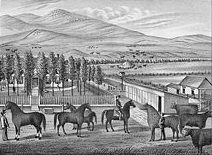
Kohrs entered the political arena in 1885, translating his economic strength into political power. He was elected to the Montana Territorial Legislature. Kohrs and his fellow ranchers had considerable influence over Montana in the years to come, and Kohrs went on to become a state senator in 1902. The big ranchers never had a free hand in Montana, however, because mining interests and farmers always kept the ranchers in check, but it wasn’t for a lack of trying. Kohrs was widely celebrated as one of the greatest pioneers in Montana history. He died on July 23, 1920 at the age of 85 in Helena.
 For many years, levee systems were built along rivers to hold back flood waters. They work very well…until they don’t. When a levee ruptures, the resulting flood is usually devastating. From June through August of 1993, the midwestern United States received an unusually large amount of rain…far more than normal. The rain led to severe flooding, particularly along the Illinois and Missouri shores. Then, on July 22, 1993, the levee holding back the flooding Mississippi River at Kaskaskia, Illinois, ruptured. The town’s people were forced to flee on barges. In all, more than 1,000 levees burst in late July, but, the incident at Kaskaskia was the most dramatic event of the flood. The town, which was virtually an island, was protected by a levee that the town attempted to shore up even after the bridge connecting the town to the riverside was wiped out by the rising river. At
For many years, levee systems were built along rivers to hold back flood waters. They work very well…until they don’t. When a levee ruptures, the resulting flood is usually devastating. From June through August of 1993, the midwestern United States received an unusually large amount of rain…far more than normal. The rain led to severe flooding, particularly along the Illinois and Missouri shores. Then, on July 22, 1993, the levee holding back the flooding Mississippi River at Kaskaskia, Illinois, ruptured. The town’s people were forced to flee on barges. In all, more than 1,000 levees burst in late July, but, the incident at Kaskaskia was the most dramatic event of the flood. The town, which was virtually an island, was protected by a levee that the town attempted to shore up even after the bridge connecting the town to the riverside was wiped out by the rising river. At  9:48am, the levee broke, leaving the people of Kaskaskia with no escape route other than two Army Corp of Engineers barges. By 2pm, the entire town was underwater.
9:48am, the levee broke, leaving the people of Kaskaskia with no escape route other than two Army Corp of Engineers barges. By 2pm, the entire town was underwater.
The rupture of the levee at Quincy, Illinois, left no way to cross the Mississippi River for 250 miles north of Saint Louis. In Grafton, Illinois, flood waters reached two stories high. Other towns fared somewhat better, but the flooding was bad everywhere. In Saint Genevieve, Missouri, the entire town turned out in a desperate attempt to raise the levee. Prisoners were even brought in to assist the effort. The river crested at a record 49 feet, just two feet below the improved levee. The flood inundated 1 million acres of prime farm land and wreaked havoc on the area’s economy. Miles of wheat fields were too saturated to harvest that season. In addition, the herbicides from the farms washed down the river and severely damaged fish farms in Louisiana. Many other people lost their jobs when barge traffic on the river was suspended for two months. The Mississippi  flood of 1993 caused $18 billion in damages and killed 52 people.
flood of 1993 caused $18 billion in damages and killed 52 people.
Levees can save lives, but when levees fail…people die, and property is destroyed. Sometimes, there is some warning, but other times, the flood that was expected, brings with it an unexpected consequence. And I can’t think of a worse unexpected consequence, than having far more water inundate an area that the flood could possibly have brought in. That was the case in 1993, and especially the case in Kaskaskia, Illinois. No one was prepared for the massive amount of water, and for 52 people, there was no way of escape.
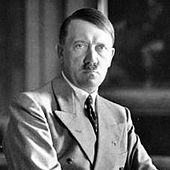 When dealing with one of the world’s more horrible murdering dictators, armies will try just about anything to take them down. Adolf Hitler seemed to be one of those dictators who just couldn’t be taken down. He even flaunted it in the face of his enemies, sending it across the airways, that he was still alive, even after they tried to kill him again. July 21, 1944, was one of those times when Adolf Hitler took to the airwaves to announce that the attempt on his life has failed and that “accounts will be settled.” Not only was Hitler good at dodging a bullet, but he was arrogant too.
When dealing with one of the world’s more horrible murdering dictators, armies will try just about anything to take them down. Adolf Hitler seemed to be one of those dictators who just couldn’t be taken down. He even flaunted it in the face of his enemies, sending it across the airways, that he was still alive, even after they tried to kill him again. July 21, 1944, was one of those times when Adolf Hitler took to the airwaves to announce that the attempt on his life has failed and that “accounts will be settled.” Not only was Hitler good at dodging a bullet, but he was arrogant too.
On this particular day, Hitler had survived the bomb that was meant to take his life. He didn’t get off unscathed, however. Hitler suffered punctured eardrums, some burns and minor wounds, but nothing that would keep him from regaining control of the government and finding the rebels. In fact, it only took a mere 11½ hours, to put down the coup d’etat, that was supposed to accompany the planned assassination of Hitler. In Berlin, Army Major Otto Remer, believed to be apolitical by the conspirators and willing to carry out any orders given him, was told that the Fuhrer was dead and that he, Remer, was to arrest Joseph Goebbels, Minister of Propaganda. But Goebbels had news for Remer.  Hitler was alive. He proved it, by getting him on the phone, because the rebels had forgotten to cut the phone lines. Hitler immediately gave Remer direct orders to put down any army rebellion and to follow only his orders or those of Goebbels or Himmler. Remer obeyed and let Goebbels go. The SS then snapped into action, arriving in Berlin, which was now in chaos, just in time to convince many high German officers to remain loyal to Hitler.
Hitler was alive. He proved it, by getting him on the phone, because the rebels had forgotten to cut the phone lines. Hitler immediately gave Remer direct orders to put down any army rebellion and to follow only his orders or those of Goebbels or Himmler. Remer obeyed and let Goebbels go. The SS then snapped into action, arriving in Berlin, which was now in chaos, just in time to convince many high German officers to remain loyal to Hitler.
What followed forth rebels was hideous. Arrests, torture sessions, executions, and suicides were the order of the day. Count Claus von Stauffenberg, was the man who actually planted the explosive in the room with Hitler. He had insisted to his co-conspirators that “the explosion was as if a 15 millimeter shell had hit. No one in that room can still be alive.” But it was Stauffenberg who would not be alive for much longer. He was shot dead the very day of the attempt by a pro-Hitler officer. There was no trial, and no second chance given.  The plot was completely demolished.
The plot was completely demolished.
Then, Hitler set out to restore calm and confidence to the German civilian population. At 1am on July 21, Hitler’s voice broke through the radio airwaves: “I am unhurt and well…. A very small clique of ambitious, irresponsible…and stupid officers had concocted a plot to eliminate me… It is a gang of criminal elements which will be destroyed without mercy. I therefore give orders now that no military authority…is to obey orders from this crew of usurpers… This time we shall settle account with them in the manner to which we National Socialists are accustomed.” The attempt on his life was over, and Hitler would live…to die another day.

 Few people know that within the United States, there lies a sovereign, independent nation, that is located in and completely surrounded by territory of the United States. The nation is called Molossian, and while this nation is not recognized by any other nation, and certainly not by the United States, its founder, Kevin Baugh, born on July 30, 1962, has declared it a nation since 1977, when he claimed it as a micronation within the United States. It is also known as the Republic if Molossia. Its headquarters is located at Kevin’s home near Dayton, Nevada. On April 16, 2016, Baugh even hosted a tour of the Republic of Molossia, sponsored by the website Atlas Obscura. Kevin Baugh continues to pay property taxes, or “foreign aid” on the land to Storey County (the recognized local government). The county lists the property identified as being within the county as Manufactured Home Converted to Real Property. Kevin Baugh has stated, “We all want to think we have our own country, but you know the U.S. is a lot bigger.”
Few people know that within the United States, there lies a sovereign, independent nation, that is located in and completely surrounded by territory of the United States. The nation is called Molossian, and while this nation is not recognized by any other nation, and certainly not by the United States, its founder, Kevin Baugh, born on July 30, 1962, has declared it a nation since 1977, when he claimed it as a micronation within the United States. It is also known as the Republic if Molossia. Its headquarters is located at Kevin’s home near Dayton, Nevada. On April 16, 2016, Baugh even hosted a tour of the Republic of Molossia, sponsored by the website Atlas Obscura. Kevin Baugh continues to pay property taxes, or “foreign aid” on the land to Storey County (the recognized local government). The county lists the property identified as being within the county as Manufactured Home Converted to Real Property. Kevin Baugh has stated, “We all want to think we have our own country, but you know the U.S. is a lot bigger.”
Molossia was a kingdom for over twenty years, followed by a People’s Democratic Republic, which then became today’s Republic in 1999 XXII. His Excellency, President Kevin Baugh is the current leader of the tiny nation. The nation encompasses a total area of 11.3 acres, Molossia is one of the smallest nations on earth, boasting just 27 citizens, but they all consider themselves citizens of Molossia for sure. A sense of humor characterizes most Molossian people, which makes sense, because you would have to have a sense of humor when you live in a nation that nobody else thinks exists. This coupled with the casual and comfortable western lifestyle, makes Molossia an enjoyable place to visit…should you ever find yourself in the area of Dayton, Nevada, about 28 miles from Reno. It is also about 28 miles from Lake Tahoe, and minutes away from Virginia City. There are some things you need to know before you decide to visit the Republic of Molossia. First, you can only visit by appointment, and upon arrival, you will have to go through customs. Another interesting fact is that the Republic of Molossia has its own currency, called the valora, which is subdivided into 100 futtrus and pegged to the relative value of Pillsbury cookie dough. Cookie dough is stored in an outbuilding called the Bank of Molossia, from which valora coins made from gambling chips and printed banknotes are sold. The Republic of Molossia also has its own Navy, Naval Academy, Space Program, Railroad, Postal Service, Bank, tourist attractions, measurement system, holidays, online movie theater, online radio station, and even its own time zone, although none of these things are recognized outside of Molossia.
The origins of Molossia come from a micronation childhood project, called The Grand Republic of Vuldstein, founded by Baugh and James Spielman on May 26, 1977, located in the same place as present day Molossia. Vuldstein was run and populated by King James I (Spielman), and Prime Minister (Baugh), although Spielman soon left “Vuldstein” and moved elsewhere, and more likely outgrew the childhood fantasy. Baugh used this name for several nomadic kingdoms as he traveled to Europe. From 1998 to 1999, Molossia was a member of the United Provinces of Utopia 3. On September 3, 1999, Baugh created the Republic of Molossia as a successor country to Vuldstein, and declared himself president. On November 13, 2012, Kevin Baugh created a petition on the Whitehouse.gov We the People website to obtain official recognition of his micronation. He declared that at the last census, held on March 18, 2012, 27 inhabitants lived in Molossia. It is the Baugh family’s primary place of residence, and the site of Molossia’s designated capital, Baughston. Baughston was renamed from Espera on 30 July 2013 to commemorate President Baugh’s 51st birthday. And true to any sovereign nation, the Republic of Molossia claims to be at war with East Germany. What is a nation without a war? The Republic of Molossia alleges that East Germany is responsible for military drills performed by Kevin 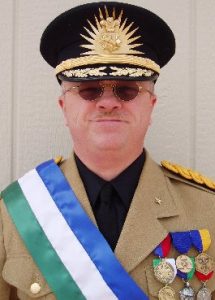
 Baugh while stationed with the United States Military in West Germany, and therefore are also responsible for the resulting lack of sleep. While East Germany formally ceased to exist in 1991 via the Treaty on the Final Settlement with Respect to Germany, Molossia argues that “Ernst Thälmann Island, through dedication by Cuba to Weimar German politician Ernst Thälmann and lack of mention in the Treaty on the Final Settlement or by the nation of Cuba either, is still East German land, allowing the war to continue.” I can’t say why Baugh believes that he can have a sovereign nation within the borders of an already sovereign nation, but apparently he does.
Baugh while stationed with the United States Military in West Germany, and therefore are also responsible for the resulting lack of sleep. While East Germany formally ceased to exist in 1991 via the Treaty on the Final Settlement with Respect to Germany, Molossia argues that “Ernst Thälmann Island, through dedication by Cuba to Weimar German politician Ernst Thälmann and lack of mention in the Treaty on the Final Settlement or by the nation of Cuba either, is still East German land, allowing the war to continue.” I can’t say why Baugh believes that he can have a sovereign nation within the borders of an already sovereign nation, but apparently he does.
 Most people know what the paddy wagon is, and nobody wants to end up in one. An old term for arresting vehicle, the term gets it’s roots from the Irish. Apparently, many of the police officers in early America were of Irish descent. According to Dictionary.com, “Irishman,” 1780, slang, from the pet form of the common Irish proper name Patrick (Irish Padraig). It was in use in black slang by 1946 for any “white person.” Paddy wagon is 1930, perhaps so called because many police officers were Irish. Paddywhack (1881) originally meant “an Irishman.” I suppose that many would look at this slang name for police officer as disrespectful, and they might be right, but no more disrespectful that pig or even cop. Nevertheless, the Paddy Wagon was just a
Most people know what the paddy wagon is, and nobody wants to end up in one. An old term for arresting vehicle, the term gets it’s roots from the Irish. Apparently, many of the police officers in early America were of Irish descent. According to Dictionary.com, “Irishman,” 1780, slang, from the pet form of the common Irish proper name Patrick (Irish Padraig). It was in use in black slang by 1946 for any “white person.” Paddy wagon is 1930, perhaps so called because many police officers were Irish. Paddywhack (1881) originally meant “an Irishman.” I suppose that many would look at this slang name for police officer as disrespectful, and they might be right, but no more disrespectful that pig or even cop. Nevertheless, the Paddy Wagon was just a 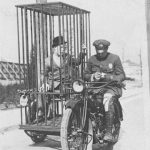 vehicle used to transport prisoners to jail. These days, unless it is a big group being arrested at one time, paddy wagons aren’t used much, but they used to be much more common. I’m sure there were many outlaws who knew the inside of a paddy wagon well…at least the ones who were’t very good at their skill. Those who were good at it usually avoided the paddy wagons.
vehicle used to transport prisoners to jail. These days, unless it is a big group being arrested at one time, paddy wagons aren’t used much, but they used to be much more common. I’m sure there were many outlaws who knew the inside of a paddy wagon well…at least the ones who were’t very good at their skill. Those who were good at it usually avoided the paddy wagons.
Back in the Old West, paddy wagons really were wagons, but then so was every other mode of personal transportation, and many forms of business transportation. With the invention of the motorized vehicle, came a different type of Paddy Wagon too. And with the invention of the motorcycle, came an even more unusual type of Paddy Wagon. I 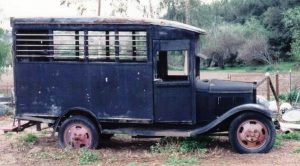 can’t really imagine being taken to jail in a cage attached to a motorcycle, but there were those who were taken that way. This seemed to be common in Los Angeles, which makes sense, because many other places would be too cold for that. Still, imagine being hauled to jail in a cage for all the locals to see. No privacy there. I suppose that would be a special type of punishment for sure, the crime and the embarrassment. Or maybe criminals don’t get embarrassed. I can’t really say. All I know is that if I ever had to be hauled to jail in a Paddy Wagon, I would prefer the type we have today, with no windows.
can’t really imagine being taken to jail in a cage attached to a motorcycle, but there were those who were taken that way. This seemed to be common in Los Angeles, which makes sense, because many other places would be too cold for that. Still, imagine being hauled to jail in a cage for all the locals to see. No privacy there. I suppose that would be a special type of punishment for sure, the crime and the embarrassment. Or maybe criminals don’t get embarrassed. I can’t really say. All I know is that if I ever had to be hauled to jail in a Paddy Wagon, I would prefer the type we have today, with no windows.
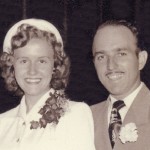
 It was 65 years ago, when my parents, Allen and Collene Spencer said “I do” and began their life journey together. Theirs was a match made in Heaven and one that continued for the rest of their lives. They knew almost from the day they met, that they had found their soulmate. Of course, my mom was too young at that time to get married, so they had to wait, but their love was worth waiting for. Finally, when my mom was almost 18, they ties the knot, and immediately moved to Superior, Wisconsin to start their family. As often happened in those days, they were quickly pregnant, and a week less than 10 months later, my sister, Cheryl Masterson was born. I arrived a little less than 2 years later; my sister Caryl Reed a little more than 3 years later; my sister Alena Stevens a little more that 2 years after Caryl; and our youngest sister, Allyn Hadlock 1 year and 8 months after Alena. By the time my sister Caryl arrived, our family had moved back to Casper, Wyoming.
It was 65 years ago, when my parents, Allen and Collene Spencer said “I do” and began their life journey together. Theirs was a match made in Heaven and one that continued for the rest of their lives. They knew almost from the day they met, that they had found their soulmate. Of course, my mom was too young at that time to get married, so they had to wait, but their love was worth waiting for. Finally, when my mom was almost 18, they ties the knot, and immediately moved to Superior, Wisconsin to start their family. As often happened in those days, they were quickly pregnant, and a week less than 10 months later, my sister, Cheryl Masterson was born. I arrived a little less than 2 years later; my sister Caryl Reed a little more than 3 years later; my sister Alena Stevens a little more that 2 years after Caryl; and our youngest sister, Allyn Hadlock 1 year and 8 months after Alena. By the time my sister Caryl arrived, our family had moved back to Casper, Wyoming.
Our parents gave their daughters a wonderful life. We may not have been rich, but we were rich in love and happiness. We traveled, we were raised to have good Christian values, and we were raised to know the value of money and hard work. It doesn’t get better than that. We grew up to be responsible citizens and my parents were proud of each and every one of their daughters. When my sisters and i grew up, Mom and Dad were blessed with 16 grandchildren, then gained 22 great grandchildren, with one more arriving in late August. They also have 5 great great grandchildren. What a crew they started all those years ago!!
Mom and Dad led a blessed life, through all their years together, and that made my sisters and me very blessed too. Our home was always filled with joy and happiness. When problems arose, Dad and Mom always 
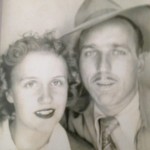 had a way to fix them. I think a strong bond and two hearts in agreement can go a long way together. Being in agreement is the biggest key to a marriage, even if you don’t agree on every matter, just agreeing to work things out is huge. Mom and Dad had that. They showed us how to live, by the way they lived. And that is the best blessing they could have given us. My only regret now is that they are not here with us anymore. Today would have been their 65th anniversary. Happy anniversary in Heaven, Mom and Dad. We love and miss you both so very much.
had a way to fix them. I think a strong bond and two hearts in agreement can go a long way together. Being in agreement is the biggest key to a marriage, even if you don’t agree on every matter, just agreeing to work things out is huge. Mom and Dad had that. They showed us how to live, by the way they lived. And that is the best blessing they could have given us. My only regret now is that they are not here with us anymore. Today would have been their 65th anniversary. Happy anniversary in Heaven, Mom and Dad. We love and miss you both so very much.

 These days, long term marriages are rare, but they can be done. It takes work, an understanding of what your spouse is going through on a daily basis, common goals, and most of all prayer. I know people would dispute that last one, but as I am a Christian, I believe that is what it takes, whether it is the couple praying, or their family praying for them. Some things should be handled with prayer, because getting along with a person day in and day out, is not always easy, as any married couple will tell you.
These days, long term marriages are rare, but they can be done. It takes work, an understanding of what your spouse is going through on a daily basis, common goals, and most of all prayer. I know people would dispute that last one, but as I am a Christian, I believe that is what it takes, whether it is the couple praying, or their family praying for them. Some things should be handled with prayer, because getting along with a person day in and day out, is not always easy, as any married couple will tell you.
Nevertheless, my daughter, Corrie Petersen and her husband Kevin are one of those couples who have beaten the odds, and today, they celebrate their 25th or Silver Anniversary. I remember their wedding like it was yesterday, because in a mother’s heart, that is exactly how it feels. They were to kids, and that’s a fact. Corrie was just two weeks past her 18th birthday, and Kevin was not quite 22. The first thought that comes to anyone’s mind is that there was no way this marriage had a chance, but these two kids loved each other so much. They had dated since Corrie was just 15 years old, and they had been engaged for a year and two weeks, since they got engaged on her 17th birthday. They were perfect for each other from the start, and never have I seen two people who were closer soulmates at such a young age. You just can’t mess with these matches made in Heaven, and that is what they were…a match made in Heaven.
Now, suddenly, here we are, 25 years later, and these two kids…who will always be kids to me…are still going strong. They are parents, and now have a new granddaughter, and they are as happy as they can be. They are supportive of each other as each one works toward their own goals for their lives. They are supportive of each other as they struggle with things that are difficult, knowing that everyone has struggles. No life is perfect, but when you have a good support system, you can do anything you set your mind to…be it health, career, 
 finances, or any other challenge people can face. You see, it isn’t the marriage that has no challenges that lasts, because in reality, there is no such thing. It is rather the marriage that meets its challenges head on, faces them with courage and compassion, and comes out the other side better for having made the journey that lasts. That is the kind of marriage Corrie and Kevin have, and that is why it has lasted. Today is Corrie and Kevin’s 25th wedding anniversary. Happy Silver Anniversary Corrie and Kevin!! Congratulations to you both…you made it!! Have a great day!! We love you both!!
finances, or any other challenge people can face. You see, it isn’t the marriage that has no challenges that lasts, because in reality, there is no such thing. It is rather the marriage that meets its challenges head on, faces them with courage and compassion, and comes out the other side better for having made the journey that lasts. That is the kind of marriage Corrie and Kevin have, and that is why it has lasted. Today is Corrie and Kevin’s 25th wedding anniversary. Happy Silver Anniversary Corrie and Kevin!! Congratulations to you both…you made it!! Have a great day!! We love you both!!

 About 47 years ago, while on a family vacation to California, my brother-in-law, Ron Schulenberg decided that he wanted to stay in California, and when asked what they should do about his older brother, Bob, Ron said,”just send for him in the mail.” Unfortunately, Ron was a little late in history for his cool little idea. You see, while the mailing of children was a practice between 1913 and 1920, Ron was living in the year 1971. Nevertheless, while Ron’s idea was workable, he cannot be credited with the original idea.
About 47 years ago, while on a family vacation to California, my brother-in-law, Ron Schulenberg decided that he wanted to stay in California, and when asked what they should do about his older brother, Bob, Ron said,”just send for him in the mail.” Unfortunately, Ron was a little late in history for his cool little idea. You see, while the mailing of children was a practice between 1913 and 1920, Ron was living in the year 1971. Nevertheless, while Ron’s idea was workable, he cannot be credited with the original idea.
When the Post Office’s Parcel Post service officially began on January 1, 1913, the new service suddenly allowed millions of Americans access to all kinds of goods and services. That was a great thing, but as is often the case, it almost immediately had some unintended consequences. Believe it or not, some parents decided to send their children through the mail. Just a few weeks after Parcel Post began, an Ohio couple named Jesse and Mathilda Beagle “mailed” their 8-month-old son James to his grandmother, who lived just a few miles away in Batavia. It seems that Baby James was just under the 11-pound weight limit for packages sent via Parcel Post, and his “delivery” cost his parents only 15 cents in postage. Of course, being the “responsible parents” they were, they did insure him for $50. As you can imagine, this “delivery” made the newspapers very quickly. While you might have thought about the outrage that would have come from such an action these days, it did not. In fact, for the next several years, similar stories would occasionally surface as other parents followed suit. One famous case, on February 19, 1914, was that of a four year old girl named Charlotte May Pierstorff was “mailed” via train from her home in Grangeville, Idaho to her grandparents’ house about 73 miles away. Nancy Pope, who wrote for the National Postal Museum wrote the story, which became so legendary, that it was even made into a children’s book, Mailing May. Luckily, little May wasn’t unceremoniously shoved into a canvas sack along with the other packages. As it turns out, she was accompanied on her trip by her mother’s cousin, who worked as a clerk for the railway mail service, according to United States Postal Service historian Jenny Lynch. It’s likely that his influence (and his willingness to chaperone his young cousin) is what convinced local officials to send the little girl along with the mail.
In the next few years, stories about children being mailed through rural routes would crop up from time to time as people pushed the limits of what could be sent through Parcel Post. The reason being that postage was cheaper than a train ticket. One of the most overlooked, yet most significant innovations of the early 20th century might be the Post Office’s decision to start shipping large parcels and packages through the mail. While private delivery companies flourished during the 19th century, the Parcel Post dramatically expanded the reach of mail-order companies to America’s many rural communities, as well as the demand for their products. Over the years, these stories continued to surface from time to time as parents occasionally managed to slip their children through the mail thanks to rural workers willing to let it slide. Finally, on June 14, 1913, several newspapers including the Washington Post, the New York Times, and the Los Angeles Times all ran stories stating the the postmaster had officially decreed that children could no longer be sent through the mail. But while this announcement seems to have stemmed the trickle of tots traveling via post, Lynch says the story wasn’t entirely accurate. Soon, it became obvious that this bizarre practice had to be stopped, and on June 13, 1920, notice was given that the Post Office would no longer let children be sent through the mail. While child 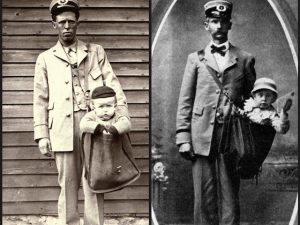
 mailing stopped, there was a time when “Mail carriers were trusted servants, and that goes to prove it. There are stories of rural carriers delivering babies and taking care of the sick. Even now, they’ll save lives because they’re sometimes the only persons that visit a remote household every day.” Still, I don’t think I would mail my child somewhere. Thankfully, there are more travel options for children these days than pinning some postage to their shirts and sending them off with the mailman.
mailing stopped, there was a time when “Mail carriers were trusted servants, and that goes to prove it. There are stories of rural carriers delivering babies and taking care of the sick. Even now, they’ll save lives because they’re sometimes the only persons that visit a remote household every day.” Still, I don’t think I would mail my child somewhere. Thankfully, there are more travel options for children these days than pinning some postage to their shirts and sending them off with the mailman.

